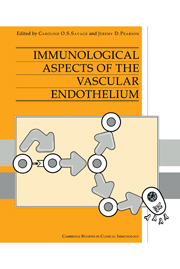Book contents
- Frontmatter
- Contents
- List of contributors
- Preface
- 1 New concepts of mechanisms in autoimmunity
- 2 Regulation of endothelial cell function by cytokines
- 3 Interactions between granulocytes and endothelium
- 4 The regulation of lymphocyte migration by vascular endothelium and its role in the immune response
- 5 Role of the vascular endothelium in immunologically mediated neurological diseases
- 6 The role of the endothelium in systemic lupus erythematosus and Sjögren's syndrome
- 7 The role of the endothelium in rheumatoid arthritis and scleroderma
- 8 The role of the endothelium in systemic vasculitis
- 9 Endothelial involvement in childhood Kawasaki disease
- 10 The role of the endothelium in thrombotic thrombocytopaenic purpura and haemolytic uraemic syndrome
- 11 The immunological role of the endothelium in organ transplantation
- Index
6 - The role of the endothelium in systemic lupus erythematosus and Sjögren's syndrome
Published online by Cambridge University Press: 04 August 2010
- Frontmatter
- Contents
- List of contributors
- Preface
- 1 New concepts of mechanisms in autoimmunity
- 2 Regulation of endothelial cell function by cytokines
- 3 Interactions between granulocytes and endothelium
- 4 The regulation of lymphocyte migration by vascular endothelium and its role in the immune response
- 5 Role of the vascular endothelium in immunologically mediated neurological diseases
- 6 The role of the endothelium in systemic lupus erythematosus and Sjögren's syndrome
- 7 The role of the endothelium in rheumatoid arthritis and scleroderma
- 8 The role of the endothelium in systemic vasculitis
- 9 Endothelial involvement in childhood Kawasaki disease
- 10 The role of the endothelium in thrombotic thrombocytopaenic purpura and haemolytic uraemic syndrome
- 11 The immunological role of the endothelium in organ transplantation
- Index
Summary
Introduction
Systemic lupus erythematosus (SLE) and Sjögren's syndrome form part of a spectrum of rheumatological autoimmune diseases of unknown aetiology. A significant proportion of patients with primary SLE may exhibit clinical features of Sjögren's syndrome (secondary Sjögren's syndrome) and share similar autoantibodies against extractable nuclear antigens.
In this chapter we discuss first systemic lupus erythematosus, referring briefly to the main clinical features of the condition, and then discussing the pathogenesis of the disease in some detail, with specific reference to endothelial activation, the evidence for the role of immune complexes in mediating endothelial damage in SLE, the mechanisms involved in immune complex processing, and the role played by erythrocyte CR1 in protecting the endothelium.
We then discuss the pathogenesis of Sjögren's syndrome, again with particular reference to the endothelium, and finally address the possible role of anti-endothelial cell antibodies in the pathogenesis of SLE and Sjögren's syndrome.
Systemic lupus erythematosus
Clinical features and epidemiology
Systemic lupus erythematosus encompasses a group of multisystem inflammatory diseases characterized by the presence of a variety of autoantibodies directed against both intracellular and extracellular antigens. The clinical features of SLE are varied, and the American College of Rheumatology classification criteria (Table 6.1) are widely used in clinical practice because of the heterogeneous nature of the disease.
The prevalence of SLE in the United Kingdom is of the order 1 per 3000 and women are affected more commonly than men (10:1).
- Type
- Chapter
- Information
- Immunological Aspects of the Vascular Endothelium , pp. 124 - 152Publisher: Cambridge University PressPrint publication year: 1995
- 1
- Cited by



